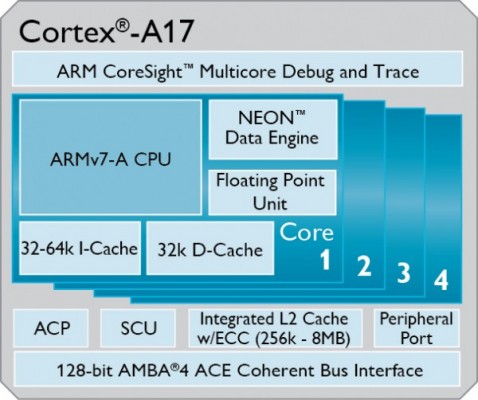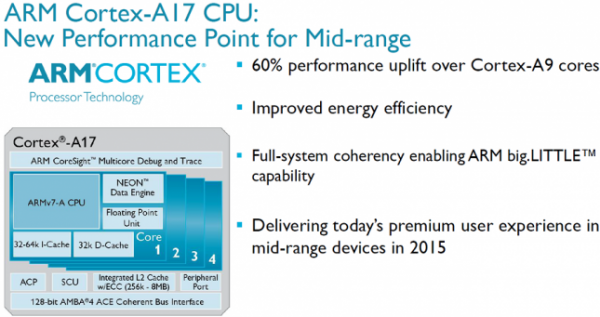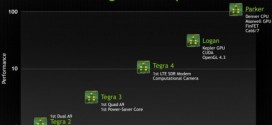ARM has announced a new mid-range core that’s supposed to be the successor of Cortex A12, called Cortex A17. The naming is a little confusing, because it implies it will be better than Cortex A15, when in fact it’s not clear it will be in terms of performance. In terms of efficiency, I’m sure it will be since it wasn’t made as a high-end CPU core, but as a mid-range one, that happens to be newer than the old Cortex A15. That’s why Cortex A17 is expected to deliver roughly the same performance but at 40 percent less power consumption.
Cortex A17 will also arrive with a Mali-DP500 DPU, sometime in 2015, most likely at the 28nm process, because it’s cheaper. It will come at clock rates from 1.5 Ghz to 2.3 Ghz. The DP500 display controller is part of a package of technologies that includes the mid-range Mali-T720 GPU, that should arrive with the Cortex A17 CPU in mid-range devices. ARM expects the mid-market to grow to 500 million units.
Even though the Cortex A17 CPU core looks pretty good performance and power consumption wise, I think ARM made a big mistake here. I already thought they made a big mistake by releasing Cortex A12 as a 32-bit core, when they were already getting ready to release the low-end Cortex A53 as 64-bit. If they were ready to release a low-end 64-bit core, why not just move the entire ARM family of cores to 64-bit? Why keep the complexity of dealing with 2 different architectures, ARMv7 and ARMv8, for so long?
ARM could’ve made a strategic decision to move entirely on 64-bit and ARMv8, going into 2015, and sell no 32-bit mobile core that isn’t 64-bit in 2015. But instead they decided to prolong the life of ARMv7 for at least another 2 years, because you can be sure that if Cortex A17 is being sold in 2015, it will also be sold in 2016, and possibly even 2017. ARM doesn’t typically release a chip that lasts only a year. It usually has a 2-year life cycle, or slightly more if it’s a really popular one (like Cortex A9 was).
Not only do I think this is bad for ARM because they can’t focus purely on ARMv8 from now on, but I also think it’s bad for the operating systems that have to support them. Obviously, even if all new devices sold in 2015 would be 64-bit, Android couldn’t become purely 64-bit this soon. It would need a 2 year period to transition.
Play Store developers, who would need to support even the oldest devices, which could be 3 or 4 years old, will need to keep a 32-bit version of their app around, too. So we wouldn’t get rid of 32-bit legacy apps very soon anyway. It would take another 3-4 years, possibly until 2018 or 2019. But this is if ARM didn’t make anymore 32-bit CPU cores like Cortex A12 and Cortex A17. But since they’re doing that, that means developers will need to support 32-bit devices much longer, if these devices keep being sold as new ones even in 2017.
Because of ARM’s illogical move, we’re not going to get rid of ARMv7 at least until 2020’s, which is disappointing, because moving to 64-bit and ARMv8 would’ve made things so much easier for everyone in the mobile industry.
 TechDomino
TechDomino




